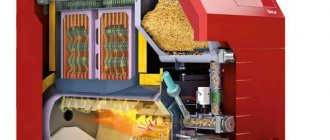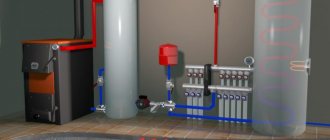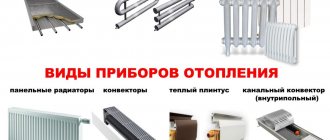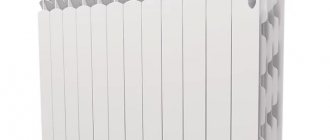In winter, the warmth in the apartment directly depends on the work of utilities. If even in severe cold the radiators in the house are barely warm, it makes sense to take heating of living spaces into your own hands. To do this, you can install a special heating element for a heating battery with a built-in thermostat. Installation of this device is simple, but it is better to take care of it before the start of the heating season. Let's figure it out in order.
Why do you need a heating element for heating radiators?
A heating element is a tubular electric heater that converts electricity into thermal energy.
A heating element installed in radiators can be the main source of heat in homes with an autonomous heating system, or an additional water heating device in centralized systems. The heating element is mounted in a cast iron battery in cases where:
- Switching to autonomous heating.
- There is not enough radiator heat for comfortable living.
- There is a need to install an emergency coolant (if there is a possibility of central heating being turned off).
Heating elements have their advantages:
- High efficiency, in a closed space there is nowhere for heat to go.
- Simple installation that every adult man can handle.
- If installed correctly, the service life is unlimited.
- It has control sensors, so the heating element for radiators is safe.
- Low cost of the device itself, variable prices for thermostats (which, as a rule, are not included in the heating element kit)
- Makes it possible to adjust heat transfer and helps save energy resources.
At the same time, the device also has vulnerabilities:
- When used as the main means of heating, it requires large electricity consumption.
- It is not recommended to use in conditions of frequently changing network voltage (or greatly reduced).
Main functions and design of the heating element
The main functions of a heating element mounted in a battery: heating the coolant and, if the heating element is equipped with a thermostat, temperature control.
The heating element for radiators itself is so simple that even a schoolchild can understand its design. An insulated conductive thread is inserted into a metal tube. Most often this is a nichrome spiral. During the galvanization process, a metal tube is coated with chromium or nickel, which gives the metal special protection from the aggressive effects of water and guarantees no human contact with electricity. In addition, the housing of the heating element is equipped with control sensors that prevent the device from overheating.
As for the coolant heating function, there are no other options except one: the device is plugged in and the water (or other coolant) is heated. The principle is the same for all electric heating devices.
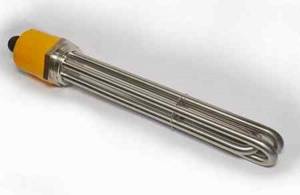
The thermostat functions are carried out by a heating element equipped with a thermostat. This allows you to set the heating element for radiators to a certain temperature. In addition, there are regulation modes that are simply necessary in certain conditions:
- “Anti-freeze” - maintains a constant coolant temperature of +10 ° C, which does not allow the heating system to freeze.
- “Turbo” is necessary for instant heating of the coolant in an autonomous heating system at maximum power. After reaching the required temperature, the mode automatically turns off and the device operates in accordance with the parameters set by the thermostat.
As for the coolant itself, there is an opinion that the most suitable for batteries equipped with heating elements is transformer oil. It heats up in a short time and gives off heat for a long time.
Conclusions and useful video on the topic
The videos provide rational advice on the use and connection of heating devices.
How to install a heating element into a radiator yourself:
We offer an overview of the heater for a cast iron radiator:
Heating element for aluminum radiator:
Radiator electric heating elements are a good way to provide additional heating for rooms for a wide variety of purposes. They are relevant for cottages, garages and buildings used from time to time.
Such heating elements are rarely recommended as the main heating. Still, they consume quite a lot of electricity, so you can find another, less expensive way to heat your home.
Are you looking for an effective device for organizing additional heating? Or do you have experience using radiator heating elements? Please leave comments and ask questions on the topic. The communication block is located below.
Types of heating elements
You can find various models of tubular electric heaters on sale. They differ in the structure of the body and the material of manufacture. Devices are also divided according to power and purpose:
- from 2.5 to 4 kilowatts - household;
- from 4 to 6 kilowatts - industrial.
There are both single heating elements and devices with two heating coils. Such devices are also made with right-hand or left-hand threads. Many models are equipped with additional options:
- Antifreeze. The function protects the heating system from possible defrosting at low temperatures. At the same time, the permissible minimum temperature is automatically maintained. During this operating mode, a completely insignificant amount of electrical energy is consumed.
- Turbo heating. This option will allow you to maximize the temperature in the room. For turbo heating to work, a thermostat is required, which makes it possible to change the heating mode.
Heating elements for radiators are produced in various lengths and with distinctive design characteristics.
Types of tubular heaters for radiators
Despite the simplicity of the design, you can find various variations of radiator heating elements on sale. First of all, the power of heating devices varies. Models with a minimum power “produce” about 0.3 kW, with a maximum – 6 kW.
The devices differ in the design of the housing. Considering that the configuration and location of radiators can be different, there are heating elements with left-hand or right-hand threads.
The diameter of the device may also vary. This is due to the cross-section of the radiator plug plug, in the place of which the device is mounted. Standard size is 40 mm.
There is no fundamental difference between devices intended for installation in radiators made of different materials. Their design is similar, only the diameter may differ. You can find single and double heating elements on sale.
The latter is more convenient to use. At the moment of switching on, both elements are activated at once, due to which the coolant heats up as quickly as possible. After this, one of the elements is turned off, which allows you to save energy resources. Some models are equipped with additional functionality.
The manufacturer uses only two functions:
- Turbo heating . Makes it possible to maximize the increase in temperature in the room. A thermostat is necessarily built into the device, which allows you to change the heating intensity.
- Antifreeze . This mode allows you to prevent possible defrosting of the entire system when the temperature drops to negative values. The heating element automatically maintains the minimum permissible temperature, while consuming a small amount of electricity.
In addition, radiator heaters vary in length and the presence or absence of a thermostat.
Application of heating elements
Tubular heaters
Installation of heating elements is so simple that any home craftsman can perform all the required work. As a rule, the heating element comes complete with everything necessary for installation, protection, connection and automation. Thanks to this, it is enough to screw a heating element equipped with a thermostat into the radiator socket and connect it to the power supply. The system must be filled with coolant. After such simple work, the heating element can be used for its intended purpose. When installing, you must ensure that the mounted heater is in a strictly horizontal position.
There are models of different capacities on the market. They are suitable not only for household but also for industrial use. The basis of the design is a stainless steel pipe with a spiral of nichrome wire placed inside. Using a brass nut with a right or left thread, the heating element is screwed into the pipeline. Such units can be used with any radiators that have a 1-inch mounting thread.
The heating element for radiators is a collapsible design, so the housing can be detached if necessary, even during operation. One of the most important issues that arise when using electric heating is safety. Among all electrical appliances, heating elements are the safest. To protect against overheating, dual control is used due to the main and additional temperature sensors. The main sensor is located inside the housing, and the additional one is in a special tube.
Differences depending on model and type of radiator
The heating element for the battery can operate in two modes. When used as the main source of heating, the heating element is turned on at full power. Thanks to this, it quickly warms up the room to a comfortable temperature and maintains it at a given level. In houses with irregular occupancy, heating elements can be used to protect the autonomous heating system from freezing. In this case, the device will operate with minimal power, maintaining the temperature of the coolant in the pipes at a level that does not allow it to freeze.
The power of the heating element is one of the main parameters when choosing a model. Low-power products will not be able to cope with the tasks assigned to them. After all, you can’t heat water in the bathroom with a small boiler—you’ll need a more powerful one. In the same way, when installing a low-power heating element, the water in the system will cool faster than it will heat up to the set temperature.
Important! Before buying this or that model, it is necessary to make calculations that allow you to use the heating device with maximum efficiency. . When calculating power, it is necessary to take into account not only the volume of water in the radiator where the heating element will be installed, but also the initial and final temperature of the coolant and the time spent by the device on heating it
To perform the most correct calculations, special formulas are used. For the average person, they can be difficult, so a full calculation is ordered from heating specialists. A simpler calculation is that the coolant temperature in a cast iron radiator should be within +70 degrees.
When calculating power, it is necessary to take into account not only the volume of water in the radiator where the heating element will be installed, but also the initial and final temperature of the coolant and the time spent by the device on heating it. To perform the most correct calculations, special formulas are used. For the average person, they can be difficult, so a full calculation is ordered from heating specialists. A simpler calculation is that the coolant temperature in a cast iron radiator should be within +70 degrees.
Modern radiator
In addition to power, it is necessary to take into account other technical parameters of the unit. The main ones are:
- Shape and diameter of the heating element tube.
- Heating tube length.
- Overall length of the device.
- Insulator dimensions.
- Mounting type.
- Type of connection to the radiator.
How does an electrical appliance work?
The design of the device is practically no different from other types of heating elements. The body of a tubular electric heater is made of a seamless or electric-welded thin-walled metal tube. Its diameter can vary, and its cross-section can be flat or round.
Carbon steel is most often used as the material for the manufacture of the case, but stainless steel can also be chosen if the working surface of the device will be heated to temperatures above +45°C.
To protect the metal from corrosion and extend the service life of the heating element itself, the steel body is chrome or nickel plated. A spiral of nichrome wire is used as a heating element.
The element has a high resistivity, due to which it heats up quickly. The spiral is placed inside the body, and the remaining free internal cavity contains filler.
The housing has high electrical insulating properties and at the same time transfers heat well. Purified quartz sand or periclase can be used as a filler - this is the name of a mixture of crystalline magnesium oxides.
After the body is filled with filler, it is pressed and bent to give the required shape. All insulators are coated with an organosilicon moisture-proofing compound.
Such a device can be installed in any type of radiator: copper, cast iron, bimetallic, etc. The device is capable of generating up to 2.5 kW of power. Models intended for industrial use produce up to 6 kW.
The design of the electric heating element is such that the device completely converts all incoming electrical energy into heat, with virtually no losses.
The operating principle of the device is extremely simple. When activated, it begins to heat up quickly, warming up the coolant located in its immediate vicinity. According to the laws of physics, a heated liquid is lighter than a cold liquid, so it begins to move upward.
A cooler coolant is lowered in its place. Having risen to the top of the radiator, the heated liquid gives off its heat there, cools down and falls down.
The cycle is repeated many times. Thus, the electrical device creates a unidirectional flow of liquid inside the battery. The higher the power of the device, the higher its speed.
Based on practice, transformer oil is considered one of the best types of coolant. The liquid heats up quickly and does not cool down for a long time, gradually giving up its heat to the radiator body.
Rules of operation and maintenance
In order for the heating element installed in the heating battery to serve as long as possible, the following rules are observed:
- The heater turns on only if there is water in the battery. If liquid gets on the already heated tube of the device, a small thermal explosion may occur. As a result, not only the heating element will fail: the heating battery may be damaged.
- During operation of the device, scale will form on its surface, which must be cleaned off periodically. The recommended maintenance schedule is once every three months. If the thickness of scale on the heating tube exceeds 2 millimeters, heat transfer will decrease and the device may fail.
- To eliminate possible voltage surges, it is recommended to connect the heating element through an uninterruptible power supply or stabilizer. When installed, the heater is grounded.
- Manufacturers recommend using only distilled water as a coolant. In apartment buildings with a common riser, it is unrealistic to comply with this requirement, so it is necessary to clean the heating elements from scale more often.
Types and methods of manufacturing heating elements
Modern electric heating elements have high strength and the ability to change shape and size under the influence of high temperatures without compromising their technical characteristics. They are used not only in household heating appliances, but also in industrial ones. True, in the latter they install more powerful analogues with larger sizes. All modern heating elements have a high rate of long-term operation.
Manufacturers produce two types of heating elements, which differ in the manufacturing method. There are products that are mass produced, and there are also those that are produced in small batches. They usually meet specific customer requests. They are used in special heating installations with specific requirements. By the way, the price of the latter is much higher than the former.
Tubular electric heaters
This is the most common type of heating element, which is used in almost all electrically powered heating devices. With the help of tubular analogues, heating of the coolant occurs according to the principles of convection, radiation and thermal conductivity as a result of the conversion of electrical energy into thermal energy.
This heating element has the following characteristics:
- Tube diameter 6.0-18.5 millimeters.
- The length of the heating element is 20-600 centimeters.
- The tube can be made of steel, stainless steel or titanium (a very expensive device).
- Device configuration - no restrictions.
- Parameters (power, performance, etc.) - as agreed with the customer.
Finned tubular electric heaters
Used to heat air or gas that heats the room
TEHPs are the same tubular electric heater only with ribs that are located in planes perpendicular to the axis of the heating tube. Typically, the fins are made of metal strip and secured to the tube with special clamping nuts and washers. The heating element itself is made of either stainless steel or structural steel.
This type of electric heating devices is used to heat air or gas that heats a room. They are often used in heating devices such as air curtains and convectors - where heating with heated air is required.
Electric heater block
TENB are used only if it is necessary to increase the power of the electric heater. They are usually installed in devices in which the coolant is liquid or any bulk material.
A distinctive design feature of the heating element is its fastening to the heating device. It can be threaded or flanged. Particularly popular today is a block-type heating element with collapsible flanges. Such a heating element can be used repeatedly for different devices. The burnt heating element can be removed and a new one put in its place.
Cartridge-type electric heaters
This type is not used for heating systems.
This type is not used for heating systems. It is used as a mold part to create any products, since it is a part of industrial equipment. They are not found in everyday life, but it is necessary to mention them, because this type of heating element is included in the category “tubular electric heaters”.
A distinctive feature of this analogue is the shell, made of stainless steel, which is polished to the maximum. This is necessary so that the heating element can enter the mold with a minimum gap between the tube and the walls of the mold. The standard gap should not exceed 0.02 millimeters. This is how tightly it should fit.
Ring electric heaters
This type of heating elements is also used only in industrial installations. Their purpose is to heat injectors, nozzles of injection units and injection molding equipment.
Electric heaters with thermostat
Heating element with thermostat TECHNO 2 kW
This is the most common heating element today, which is used to heat liquids. It is installed in all household electrical appliances that are associated with heating water. The maximum temperature of the released heat is +80C.
It is made from nickel-chromium wire, which is filled inside the tube with a special compressed powder. The powder is magnesium oxide, which is a good insulator of electric current, but at the same time has a high thermal conductivity.
Which heating element for a radiator should I choose?
Since there is no great variety in the design and technical features of radiator heating elements, problems in choosing usually do not arise.
When purchasing, you should pay attention to the following:
Power - if there is no information about thermal standards for a specific area, you can select a device based on average indicators for central Russia, adjusting them in accordance with the weather conditions of the region. Thus, a heating element with a power of 1 kW is capable of heating the air in a room with an area of 10 m2, provided that there is an autonomous heating system. From this calculation the choice should be made.
Material - there are no particular differences in materials between radiator heating elements from different manufacturers. Their designs are also identical. The difference may be in diameter, that is, in the size of the plug plug. In addition, there are single and double heating elements.
Size - since a heating battery can consist of a certain number of sections, the length of the heating element must correspond to the length of the battery. Experts recommend purchasing a heating structure whose rod is 6-10 cm shorter than the length of the battery. If the heating element is shorter than the required length, it will not be able to provide complete and uniform heating of the coolant.

Availability of additional equipment - if you plan to install an autonomous heating system, then it is better to install models with a thermostat. This will allow you to regulate the temperature in the rooms and reduce electricity costs.
Price is the main thing, do not purchase a heating element for a radiator, putting its cost at the forefront. First of all, you need to be guided by the technical characteristics specified in the product passport. And always remember, cheap doesn’t mean good!
Calculations of the required power of the heating element
When you plan to install an autonomous heating system in a permanent home, it is especially important to correctly calculate the required power of the device. How to do it?
The technical documentation for radiators indicates the exact heat transfer values, say, for one cast iron section it will be 140 W. These values must be multiplied by the number of sections. Thus, the required power of the heating element will be obtained.
How to choose the right heating element for a cast iron radiator
For a heating element to truly become an effective assistant, you need to select it according to the following parameters:
- First of all, you should focus on the power of the heating device. To select the power of a heating element for a cast iron battery, you need to calculate what it should be. If we focus on SNiP indicators, then 1 kW of power will be required to heat 10 m2, but this is not the only indicator that should be taken into account.
- Of considerable importance is what metal it is made of and how the heating radiator works. There is a difference between heating elements for cast iron batteries and aluminum or bimetallic ones. For the former, heating elements of a different shape and with a larger plug diameter are produced.
When purchasing a heater, you need to clarify what type of radiators it is suitable for.
- To choose the correct heating element length, you need to focus on the number of sections in the radiator . As a rule, the optimal length of the device is 10 cm shorter than the battery. This will allow it to heat the coolant in the device evenly and quickly.
- You can install a heating element in a heating radiator with a thermostat if it will be used as an additional heat source. When its function is to heat a house or apartment, additional external electronics will be required to automate the heating process. This makes the device itself somewhat more expensive, but helps save on energy resources during its operation.
- The pressure in the central heating batteries should also be taken into account. If it tends to increase, then you should periodically bleed the air using a Mayevsky tap.
Important: when purchasing a high-quality heating element, you should approach it not from the standpoint of price, country of origin and quality, but according to the technical characteristics specified in the data sheet
As a rule, inexpensive Chinese models immediately attract attention, but you should not rely on cost when the heating element should become the main source of heat. In this case, you will need a reliable and powerful device, and it cannot be cheap
Filling the radiator with water
How much liquid is needed for such a heater?
Mistake #10
When filling a radiator, you don’t want it to end up 100% full of water.
Filling occurs through the hole of the already installed passage plug. First, fill the radiator up to the neck.

Then you set it perfectly level and unscrew the plug or the Mayevsky valve (not the fitting itself), draining the excess volume.

If the battery is already hanging on the wall, you can use a small watering can with a tube or hose stretched over the spout.
Mistake #11
Try not to use regular tap water.
The water should be soft. A hard one will kill your heater very quickly.
Distilled or rainwater is best (it's free). As a last resort, water from an osmosis filter.
Just enough water is needed so that it stops flowing through the hole under the Mayevsky tap. That is, the liquid level should end exactly at the level of the small hole in the passage fitting.

When pouring water along the edge of the hole, you will automatically get the desired level of the liquid column, which will ensure uniform, proper circulation.
One section of a cast iron battery (MS 140-500) holds about 1.5 liters of water. In aluminum (height 500mm) - no more than 0.35-0.45 liters. The required volume is calculated by the number of ribs.
Features of choice
Electric heaters designed for radiators may differ in several parameters. Therefore, you should approach the choice wisely
Below we will consider what you should pay attention to when choosing a heating element.
Power is one of the most important parameters, since the heat transfer of the device depends on it. Therefore, first of all, you need to calculate the required power for comfortable heating of the room.
On average, 1 kW of power is required for every 10 m2. For a more accurate calculation, it is necessary to take into account the region and heat loss of the room. However, if the heaters are used as an additional heating element, then half the power is sufficient.
Note! It makes no sense to use a heater more powerful than 75 percent of the heat output of the radiator itself, since its capabilities will not be fully used.
Bimetallic radiator with electric heating element
Radiator type
Heating elements for aluminum heating radiators and bimetallic batteries are structurally no different from heating elements for cast iron appliances.
However, the differences are in the following points:
- The shape of the outer part of the body.
- Plug material.
The heating element for an aluminum radiator has a plug with a diameter of one inch. The diameter of the plug for standard cast iron batteries is 1¼ inches.
Therefore, before purchasing a heater, you should pay attention to what types of batteries it is intended for. This information is usually contained in the instructions included in the kit.
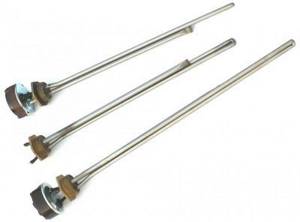
Heating element length
An important selection parameter is the length of the heating element. As you might guess, the uniform heating of the battery and the circulation of liquid depend on this. Accordingly, the length is selected depending on the number of sections of the device.
Ideally, the heating element should be 10 cm shorter than the battery. In this case, the liquid will be heated as evenly as possible.
Automation
Automation can be built-in or external. It should be noted that a radiator heating element with a built-in thermostat is cheaper than the components separately. However, outdoor electronics tend to be more functional.
The choice depends on the purpose of the heater. If it is to be used as the main heat source, external electronics can be installed to ensure maximum heating comfort. If the device is planned to be used as an additional one, a heating element for heating radiators with a thermostat in one housing is also suitable.
Inexpensive heating element with thermostat for cast iron radiator
Manufacturer
As for the manufacturer, in this case the choice is not so important. The fact is that well-known European companies do not produce this equipment. Therefore, as a rule, you can find products of Polish, Ukrainian and Turkish origin on the market.
All these heating elements are quite similar in quality, so more attention should be paid to their characteristics. The only thing is that it is better to refrain from purchasing Chinese products, since suppliers often import the cheapest, low-quality models. However, even among them sometimes there are decent heaters.
These are, perhaps, all the main points that are important when choosing heating elements for batteries.
The use of heating elements for radiators does not provide any benefits compared to other types of electric heating. However, these heaters are an excellent option for heating all kinds of utility rooms. In addition, they can be used as an additional or emergency heat source.
Radiator electric heating at home
Installation diagram of the heating element in the radiator
Before installing the heating element into the heating system, you need the parameters of the radiator. The main one is the diameter of the connecting pipe. Currently, manufacturers produce products in two sizes - 1/2 and 3/4 inches. Then a comparative analysis of the heating parameters is carried out before and after installing the heating element.
Connecting the heating element to the existing heating
If it will be used as an additional method of heating water, you need to take into account the change in hydraulic pressure when passing through the radiator. Since the flow diameter of the system this month will be smaller, it is recommended to install a pump of higher power.
They are often installed in old cast iron batteries. Before performing work, you must first check the direction of the thread of the pipe (right or left) and also measure its diameter. Then you should follow this scheme:
- Coolant drain. It is prohibited to install a heating element into a heating radiator if there is water in it;
- Checking the battery level. Even at a slight angle of inclination, the likelihood of air pockets significantly increases;
- Installing the heating element into the pipe. To seal the holes, you must use the gaskets supplied with the heating element or make them yourself;
- Installation of a unit with a thermostat, if included.
An example of installing a heating element in a cast iron radiator
After this, you need to fill the system with water. Using the installed Mayevsky crane, possible air pockets are removed. Before switching on, to ensure safety, a tester is used to check any possible heating coil-battery circuit. If there is one, you need to dismantle the heating element and install it again, improving the sealing.
Radiator electric heating
When organizing heating using heating elements made by yourself, installation of a pipeline is not necessary. A heating element must be installed on each radiator. At the same time, it is possible to install models of different power depending on the thermal conditions in a specific room of the house. The advantages of such a system are as follows:
- Saving on the purchase of materials and reducing the labor intensity of installation work;
- If you use a heating element with a thermostat for heating and a temperature sensor connected to it, the degree of heating of the room will be adjusted automatically;
- Minimum system heating inertia.
But all these positive qualities can be offset by the total cost of service. Therefore, before heating with electric heaters, you need to calculate not only the cost of purchasing materials and components, but also the subsequent costs of electricity. Only after this should a heating system of this type be introduced.
Advantages and disadvantages
You can reduce heating costs by purchasing a heating element with temperature control
A tubular thermostat can be used to create an efficient heating system used as additional or main heating.
Main advantages:
- Easy to install. Even an inexperienced person can cope with the task.
- Possibility of automatic control if the system is equipped with additional equipment.
- Acceptable cost of construction.
- Compared to oil radiators, the system is more reliable. The batteries are repairable.
Among the disadvantages, it is worth highlighting the impressive operating costs due to the high cost of electricity. It is possible to reduce consumption, but to do this you will have to additionally purchase an automated control system.
How to choose heating elements
Heating element for heating with plates
How to choose the right heater for a heating system? Currently, there are many manufacturers who offer similar products. However, both quality and technical parameters do not always meet the required
Therefore, before purchasing, you need to pay attention to the following operational characteristics of the heater:
- Rated and maximum power. If a heating element is needed for a heating boiler, its power should be sufficient for the system to operate. The simplest method of calculation is per 10 square meters. at home you need 1 kW of thermal energy;
- Electrical network type. For models with power up to 3 kW, you can use a 220 V home network. If you plan to install a heater for a heating system of higher power, you should install a three-phase 380 V network. This may be due to difficulties in completing the documentation;
- The presence of a thermostat. For a radiator electric heating system, this is the main selection factor. If you purchase a heater without the ability to adjust the power, it will constantly work at maximum mode. This will dramatically increase electricity costs;
- Price. The average price of a 2 kW model starts from 900 rubles. The cost of more powerful ones can be up to 6,000 rubles. They are often made to order.
The appearance of the heating element can also affect its performance and efficiency. The best option would be to purchase a finned heating element for a heating boiler. It differs from conventional ones in that additional heat exchange plates are located on the protective shell.
Thanks to them, the heating area increases. This design is typical for heating elements in heating radiators of larger diameter. Reviews about them indicate increased heat transfer even at minimum operating mode. But their overall dimensions do not always make it possible to install them in a battery. Therefore, simple tubular type heaters are most often purchased. To increase efficiency, you can buy a block of heating elements with a thermostat. It differs from traditional ones by the presence of several heating elements on one base.
Features of self-installation of heating elements in the battery
The ease of installation of the device corresponds to the simplicity of its design. You should also check the package contents in the store; ideally, everything needed for connection should be packed in the box. If something is missing, you need to buy it immediately.
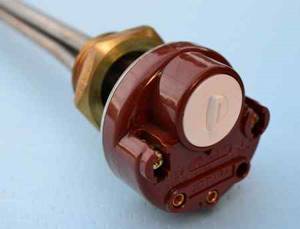
Installation of the heating element is carried out in the following sequence:
- Free the system from water;
- Remove the bottom plug from the radiator;
- Install the heating element instead of the plug - treat the joint area with sealant or wrap flax around the threads, rubber gasket, and install the heating element strictly horizontally;
- Fill the radiator with coolant;
- Connect the device to the network. Important! To connect the heating element to the network, it is prohibited to use a socket without grounding!
Over time, during operation, the heating element becomes covered with scale, which can lead to breakdown. It is easier to regularly monitor the condition of the heater and clean it in a timely manner. For these purposes, the heating element is removed from the radiator, and scale is removed from it in one of two possible ways.
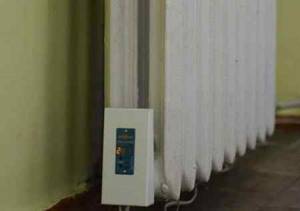
Mechanically - the surface is wiped with sandpaper or a wire brush. To avoid damage to the surface, this operation should be carried out very carefully. Chemical - the surface of the heating element body must be treated with an appropriate composition. This must also be done carefully, and in no case should the cleaning solution come into contact with the rubber gasket.
Recommendations for the safe operation of a radiator equipped with a heating element
You can use an electric heater installed in batteries if the following conditions are met:
- Availability of adequate ventilation in the room;
- Do not place flammable objects and substances close to a working heating element;
- Before installing the heating element, you need to make sure that there is no damage to the electrical wiring and that it has sufficient power;
- You cannot dry clothes or shoes on a battery with a heating element.
Radiator heating elements can be either the main or additional source of heating. But such a heating system is still more suitable for small rooms that are used periodically: utility rooms, garages, closed verandas, and, of course, country houses that are rarely visited in winter.
Rules for installing a heating element in a battery with your own hands
Before installing the heating element, it is necessary to drain the water from the system
To install a heating element into a battery, you do not need specific knowledge and skills. The main thing is to strictly follow the instructions and comply with safety requirements.
- It is imperative to stop the water supply to the radiators and drain the remaining water from the system.
- Remove the bottom plug and install an electric heating element in its place.
- After tightening the plug, the electronics are installed and water is again supplied to the system to check the tightness.
Safe installation rules:
- It is prohibited to use heating elements if the room is not equipped with a proper ventilation system.
- There should be no flammable objects near the device connected to electricity.
- Before you begin designing and installing a heating element, you need to make sure that the electrical wiring can withstand the additional load.
- It is prohibited to dry shoes and clothes on radiators connected to the network.
Modern electric heating elements combine a large number of advantages, due to which the demand for them is growing.
Radiator electric heating at home
Installation diagram of the heating element in the radiator
Before installing a heating element into the heating system, you need radiator parameters. The main one is the diameter of the connecting pipe. Currently, manufacturers produce products in two sizes - 1/2 and 3/4 inches. Then a comparative analysis of the heating parameters is carried out before and after installing the heating element.
Connecting the heating element to the existing heating
If it will be used as an additional method of heating water, you need to take into account the change in hydraulic pressure when passing through the radiator. Since the flow diameter of the system this month will be smaller, it is recommended to install a pump of higher power.
When connecting a radiator to the system, installing a heating element for heating the house will not be possible. To do this, you must either change the connection diagram to the top, or install a heating element on the top of the battery, which is not recommended by experts.
They are often installed in old cast iron batteries. Before performing work, you must first check the direction of the thread of the pipe (right or left) and also measure its diameter. Then you should follow this scheme:
- Coolant drain. It is prohibited to install a heating element into a heating radiator if there is water in it;
- Checking the battery level. Even at a slight angle of inclination, the likelihood of air pockets significantly increases;
- Installing the heating element into the pipe. To seal the holes, you must use the gaskets supplied with the heating element or make them yourself;
- Installation of a unit with a thermostat, if included.
An example of installing a heating element in a cast iron radiator
After this, you need to fill the system with water. Using the installed Mayevsky crane, possible air pockets are removed. Before switching on, to ensure safety, a tester is used to check any possible heating coil-battery circuit. If there is one, you need to dismantle the heating element and install it again, improving the sealing.
Radiator electric heating
When organizing heating using heating elements made by yourself, installation of a pipeline is not necessary. A heating element must be installed on each radiator. At the same time, it is possible to install models of different power depending on the thermal conditions in a specific room of the house. The advantages of such a system are as follows:
- Saving on the purchase of materials and reducing the labor intensity of installation work;
- If you use a heating element with a thermostat for heating and a temperature sensor connected to it, the degree of heating of the room will be adjusted automatically;
- Minimum system heating inertia.
But all these positive qualities can be offset by the total cost of service. Therefore, before heating with electric heaters, you need to calculate not only the cost of purchasing materials and components, but also the subsequent costs of electricity. Only after this should a heating system of this type be introduced.
It is recommended to purchase factory radiators with installed heating elements. Their operating efficiency is higher than that of homemade ones, since special oil is used as a coolant. Even when the heating element is turned off, it will give off heat to the room for some time.
Installing a heating element: important features
The heating element is installed according to the following scheme: one of the battery plugs is unscrewed, and a heating element is installed in its place using a threaded connection. To ensure the tightness of the joint, a rubber gasket is used.
Mr. Build recommends: it is best to screw in heating elements instead of the bottom plug. There is a logical explanation for this: heated water will rise and cold water will fall, which will ensure efficient operation of the heating element.
This procedure is repeated in each room of the apartment. We remind you that installation is carried out before the start of the heating season.
It is important! Shut-off valves and a bypass must be installed near the radiator to which the electric heater is planned to be connected. If there are no valves, all the heat will go to the neighbors. In the absence of a bypass, the general building heating system will be disrupted.
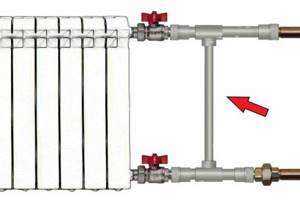
A few more important points:
- Do not use excessive force during the installation process. There is no need to forcefully tighten the contact nuts and the heating element fasteners themselves. Brittle material may burst.
- It is strongly recommended that after the shut-off valve, install a safety valve or a small expansion tank with a volume equal to 10% of the battery volume. This is due to the fact that when the coolant in a closed system is heated, it expands and increases the pressure in it.

Safety precautions and operational points
A heating element is a mains-powered heater. When using the device, it is quite important to follow some rules that will ensure safe use and significantly extend its service life:
- In order for the device to operate for a long time with full heat transfer, the scale that forms on its surface should be cleaned once every three months. If a large layer of white deposits forms, it can damage the device. The intensity of scale formation can be reduced by using distilled water as a coolant.
- Do not allow the electric heater to overheat. The temperature of the radiator in the place where the electric heater is installed should not reach seventy degrees above zero. Therefore, it is quite important to choose the correct power of the heating element.
- The heater can only be turned on in a battery filled with coolant. If water enters an already heated electrical appliance, it can lead to a thermal explosion. As a result, not only the radiator, but the entire heating system may be damaged.
- If static electricity appears on the surface of a tubular device, it must be immediately turned off and all connections and the device itself checked for leaks.
- The heater power should not be higher than the thermal rated power of the battery. A load of no more than 3.5 kilowatts is allowed in one outlet.

Installation of the heating element in the heating radiator is carried out only using grounding. To avoid voltage drops, it is best to connect the electric heater to the network through a stabilizing device.
First start - pressure testing of the autonomous heating system

Having installed the radiator on the wall, we connected it. After 20 minutes the battery reached operating temperature.
It heats well, but on the one hand, where the heating element has a slightly higher temperature, it is not critical.
There are no leaks, the seal is not broken.
VIDEO: Heating element with an aluminum radiator - temporary heating of the house
Heating element with an aluminum radiator - temporary heating of the house
How to connect a heating element to an aluminum radiator [Instructions]
Efficiency mark
A heating element for a radiator is not a heating device that can be constantly used to heat a large area. One kilowatt of electrical appliance power is converted into one kilowatt of thermal energy, which is completely used to heat the room.
When using cast iron batteries, a heating element equipped with a thermostat with a heating power of 100 Watt/m² can heat no more than 25 m² of space. Electrical energy consumption for twenty-four hours will be 36 kW/h, which approximately corresponds to 167 rubles. This takes into account the average power consumption of 1.5 kW. If the heating system is well organized, installing a tubular type electric heater does not make sense.
A heating element for a radiator is most effectively used as an emergency device. If the heating system is unstable, such a device will allow you to maintain the required level of heat in the room even in severe frosts. Installing a tubular heater makes sense if its power is correctly selected and all safety rules are observed.
Design and principle of operation
On the heating equipment market, heating elements are presented in models that differ in power and performance characteristics, while most of them work on the same principle. In particular, an electric heating element for radiators is a heating element that is mounted in a special socket on the radiator and is used to heat the coolant circulating inside the heating system.
The standard equipment of the heating element includes a protective casing that prevents electric shock when using the device and a thermostat.
The thermostat allows you to most effectively control the heating process of the coolant. When making heaters for heating radiators, manufacturers subject them to a galvanization process, as a result the finished product has excellent consumer characteristics - long service life, reliability and durability, and ensures uninterrupted operation of the home heating system. In order not to depend on centralized heating, many often choose individual heating.
Conclusion
Installing a heating element is one of the ways to ensure comfort and coziness in residential premises. This design can be compared to an electric oil radiator, but it provides faster and more uniform heating of all rooms in the apartment. But you need to keep in mind that with constant use of such a device, electricity bills will increase very significantly. The installation sequence of radiator heating elements is shown in the video below.
Sources
- https://samastroyka.ru/ten-dlya-radiatorov-otopleniya.html
- https://pechiexpert.ru/ten-dlya-radiatora-01/
- https://www.tproekt.com/montaz-tenov-v-batarei-otoplenia-s-termoregulatorom/
- https://StrojDvor.ru/otoplenie/kak-vybrat-i-podklyuchit-ten-dlya-radiatora-otopleniya/
- https://mr-build.ru/otoplenie/ten-v-batareyu-otopleniya-s-termoregulyatorom.html/
- https://otopleniehouse.ru/ten-dlya-radiatora/
[collapse]

